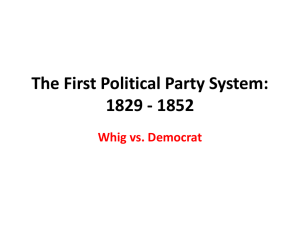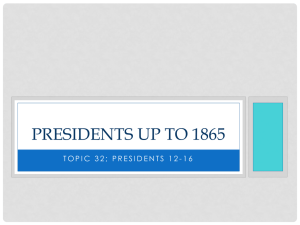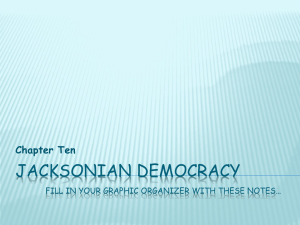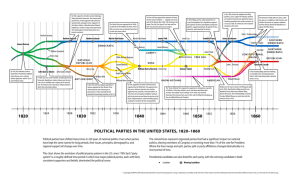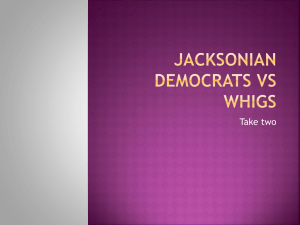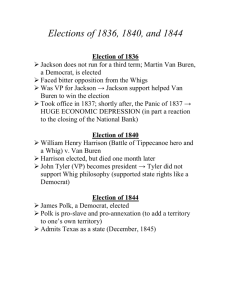The First Political Party System: 1829 - 1852
advertisement
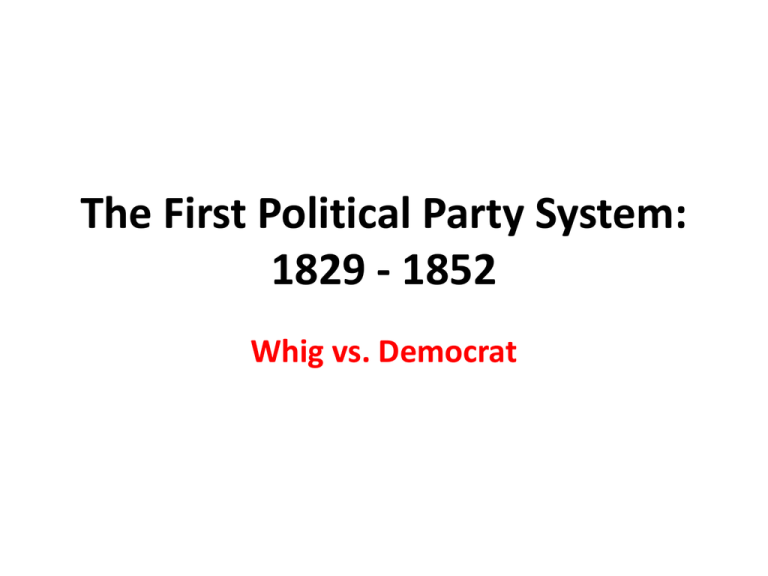
The First Political Party System: 1829 - 1852 Whig vs. Democrat A. The Founders Tried to Duck The Issue: 1. Section. 2. Clause 3: Representatives and direct Taxes shall be apportioned among the several States which may be included within this Union, according to their respective Numbers, which shall be determined by adding to the whole Number of free Persons, including those bound to Service for a Term of Years, and excluding Indians not taxed, three fifths of all other Persons. 2.Section. 9. Clause 1: The Migration or Importation of such Persons as any of the States now existing shall think proper to admit, shall not be prohibited by the Congress prior to the Year one thousand eight hundred and eight, but a Tax or duty may be imposed on such Importation, not exceeding ten dollars for each Person. 3. Amendment XIII. (ratified 6 December 1865) Section 1. Neither slavery nor involuntary servitude, except as a punishment for crime whereof the party shall have been duly convicted, shall exist within the United States, or any place subject to their jurisdiction. Section 2. Congress shall have power to enforce this article by appropriate legislation. The Invention of the Cotton Gin by Eli Whitney in 1793 By 1860 Cotton Exports were $192,000,000 or four times U.S. Government revenues. About 86% of the Cotton was grown on farms of 100 or more acres. England imported about 80% of its Cotton from the South and about 1.5 million people were employed in the English Textile mills. The expansion of the Cotton-based Slavery system into the Southwest accounts for much of the potency of the Territorial Issue. The Whig-Democrat Political System – 1826 – 1852 (Whigs collapsed after the Compromise of 1850). 1.Basically Competitive With a Slight Advantage to the Democrats. 2.Both Parties had Support in the North and the South. 3.Two Basic Issues – Economic Regulation and Slavery. John Gerring (1998): Whig-Republicans – valorized work and social harmony; mercantilists – the state had an important role in ensuring economic development; statists – believed in strong government which properly channeled the voice of the masses through institutions rather than direct expression; order – against unrestrained individualism; Yankee Protestants – believed that humans had a responsibility to reform themselves; Nationalists – preeminence of American interests and ideals. Favored aggressive trade policies, internal improvements, and industrial policies to stimulate economic growth. John Gerring (1998): Democrats: “From 1828 to 1892, Democratic leaders steadfastly defended a pre-industrial economic order, limited government, and the liberties of white people. Forged from the unlikely combination of racism, anti-statism, and civil republicanism, this ideology is most accurately and concisely described as Jeffersonian.” Democrats did not condone rather, they were pro-White. slavery – “Throughout most of the 19th century, Democratic leaders adopted tight fiscal, currency, and monetary policies: hard currencies (gold and/or silver), balanced budgets, little government borrowing (and quick repayment), low spending and low tariffs.” Democrats opposed the National Bank and Internal Improvements – such policies FAVORED BUSINESS AND THE MERCHANT CLASSES. Democrats opposed Tariffs because they were a TAX (ALSO HURT THE SOUTHERNERS). Democrats favored state and local government because they saw them as being more under popular control. The Federal Government was remote and should be small and should protect private property. Federal government. They opposed an activist The party was anti-corporate and anti-capitalist – the protector of the common people. “…the economic philosophy of the early Democratic party is perhaps more accurately encapsulated in the terms agrarianism, producerism, or … civic republicanism …” A Near Party Line Vote in the House in 1841 Slavery Petition Vote, 1841 Presidential Elections: 1828 - 1860 Democrat Whig ---------------------------------------------------------------1828 Jackson 178 642,553 Adams 83 500,897 1832 Jackson 219 701,780 Clay 49 484,205 1836 Van Buren 170 764,176 Harrison 73 550,816 1840 Van Buren 60 1,128,854 Harrison 234 1,275,390 1844 Polk 170 1,339,494 Clay 105 1,300,004 1848 Cass 127 1,223,460 Taylor 163 1,361,393 1852 Pierce 254 1,607,510 Scott 42 1,386,942 ---------------------------------------------------------------Republican American/Whig 1856 Buchanan 174 1,836,072 Fremont 114 1,342,345 Fillmore 8 844,032 1860 Douglas 12 Lincoln 180 Breckinridge 72 Bell 39 (Fusion) 0 1,004,042 1,855,276 672,601 590,980 553,570 21.47% 39.67% 14.38% 12.64% 11.84 Northern Democrat Republican Southern Democrat Unionist Misc. Fusion Tickets Congressional Elections: 1826 - 1858 HOUSE SENATE Jackson Anti-Jackson Nullifiers Jackson Anti-J. Nullifiers Democrat Whig Anti-Masons Democrat Whig Anti-Masons 1826 113 100 27 21 1828 136 72 25 23 1830 126 66 21 24 22 2 1832 143 63 34 20 26 2 1834 143 75 24 26 24 2 1836 128 100 13(1) 35 17 1838 125 109 6(2) 30 22 1840 98 142 (2) 22 29 (1) 1842 147 72 (4) 23 29 1844 142 79 (6A,1) 34 22 (2) 1846 110 116 (1A,2) 38 21 (1) 1848 113 108 (1A,9F,2) 35 25 (2F) 1850 127 85 (4F,10U,7) 36 23 (3F) 1852 157 71 (4F,2) 38 22 (2F) ----------------------------------------------------------------Opposition Opposition Republican Republican 1854 83 100 (51A) 39 22 (1A) 1856 132 90 (14A,1) 41 20 (5A) 1858 83 116 (5A,36) 38 26 (2A,2) The Economy Before the Civil War – How it Interacted with the Democrat-Whig Political Party System 1.U.S. Long on Resources and Short on Population -- Result, capital intensive development. 2.The Creation of the modern economy during the 1840s to the 1890s was due to cheap energy in the form of coal, mass transportation in the form of the railroads, and mass communication in the form of the telegraph. 3. Different Patterns of Economic Development in the North and South. 4. North – Expansion of Transportation Systems and Industrialization. 5. South – EXPANSION OF COTTON-BASED SLAVERY
